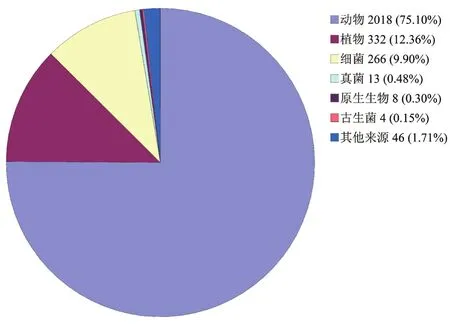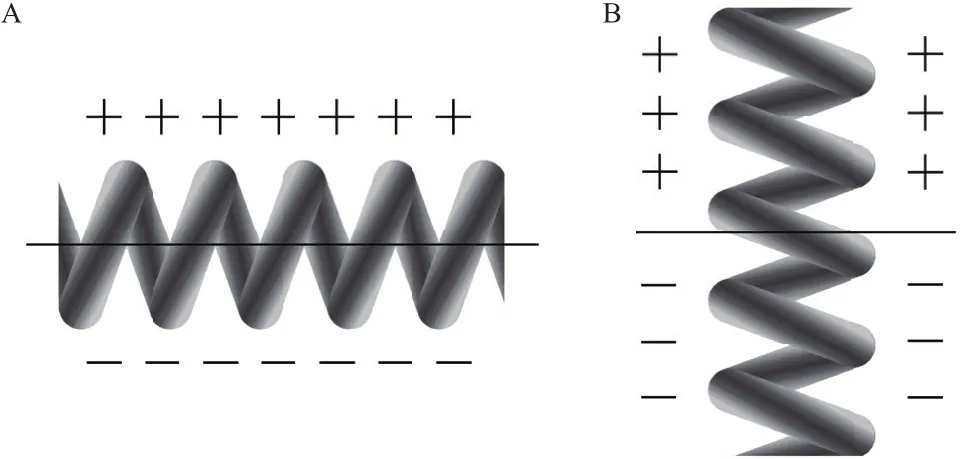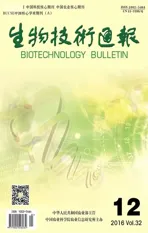生物信息学用于抗菌肽预测和分子设计的研究进展
2016-12-12肖轶尘熊浩谢川吕农华
肖轶尘熊浩谢川吕农华
(1. 南昌大学江西医学院,南昌 330006;2. 第一临床医学院,南昌 330006)
生物信息学用于抗菌肽预测和分子设计的研究进展
肖轶尘1熊浩1谢川2吕农华2
(1. 南昌大学江西医学院,南昌 330006;2. 第一临床医学院,南昌 330006)
抗菌肽(AMP)以其特异性抗菌、抗病毒、抗肿瘤功能及快速、广谱、高效等特点,迅速成为具有重要研究价值的新型生物活性肽。寻找合适方法最大限度提高其活性,降低毒性和成本,是新型抗菌肽药物研发过程中面临的首要问题。应用生物信息学工具对新型抗菌肽进行预测或对天然抗菌肽进行分子设计成为解决这一问题的关键。对生物信息学在抗菌肽预测和优化设计中的最新进展进行综述,以期扩大抗菌肽的来源,提高现有抗菌肽的生物活性。
抗菌肽;生物信息学;活性肽预测;分子设计
抗菌肽(antimicrobial peptide,AMP),又称宿主防御肽(host defense peptide,HDP),是一类具有抗菌活性多肽的总称,是生物体先天免疫系统的重要组成部分[1,2]。与传统抗生素相比,抗菌肽具有广谱杀菌作用,对大多革兰氏阳性菌和阴性菌均起作用,而且对某些真菌、寄生虫有杀灭作用,并能选择性地杀伤肿瘤细胞,抑制乙型肝炎病毒(HBV)、艾滋病毒(HIV)等的复制[3,4]。因此,对抗菌肽的研究主要集中在其药用价值开发和免疫调控,如预防及治疗癌症、抗病毒、抗感染等。
但天然抗菌肽存在生产成本较高、部分抗菌肽对哺乳动物细胞有一定的毒性[5]、杀灭病原微生物的同时常伴有溶血活性[6]和蛋白酶抑制活性[7,8]等问题。因此,进一步提高抗菌活性、降低合成成本以及最大程度降低其副作用成为抗菌肽分子设计的关键所在,也是抗菌肽药物开发的重点和难点。抗菌肽的结构可以分为4类:α-螺旋、β-折叠、环形和伸展性结构[9],抗菌肽的预测和分子设计主要围绕这几类抗菌肽分子展开。
抗菌肽分子设计基于结构与功能关系,通过生
物信息学、分子生物学等一系列方法,对天然抗菌肽定向优化或从头设计,获得更高效低毒、更优药代动力学的多肽序列,进一步了解其活性机制,并应用于生产生活[10]。到目前为止,国内外学者用不同的方法对抗菌肽进行预测和氨基酸序列的改造,其中,生物信息学辅助的抗菌肽预测和改造技术发挥了非常重要的作用[11]。本文对这一领域的最新研究进展作一综述,以期扩大抗菌肽的来源,提高现有抗菌肽的生物活性。
1 抗菌肽预测和分子设计常用生物信息学工具
为了进一步扩大抗菌肽的来源,人们用已知自然来源的抗菌肽为模板预测并设计新型抗菌肽。基于对抗菌肽前体和成熟抗菌肽的认识,研究人员开发了用于抗菌肽预测和设计的生物信息学工具(表1)。本文总结的抗菌肽的预测和分子设计方法中所用到的生物信息学分析工具都在表1中详细给出。表1中包含了3个主要的抗菌肽数据库和7个常用抗菌肽分析工具,涉及到抗菌肽的序列、理化性质、结构信息、结构预测和分子设计等功能。

表1 抗菌肽预测和分子设计常用在线分析工具
2 基于抗菌肽库的抗菌肽预测
由于序列和结构的多样性,抗菌肽的预测是一项困难但意义重大的工作,抗菌肽库(APD)[22]的建立使之成为可能,鼓励了科学家在这个研究方向上努力。截止到2016年4月,APD共收录了6个生物界的2 687条抗菌肽分子,每种生物来源的抗菌肽数目及占比,见图1。

图1 抗菌肽库中全部抗菌肽生物来源分类图
很多成熟的抗菌肽序列收录在APD中,研究人员逐渐产生了利用APD预测抗菌肽的想法[23-25]。一些实验室整理了大量抗菌肽与其靶标微生物对应关系的信息,建立了数据集,这些数据集已经被用来预测和验证新型抗菌肽候选序列的生物活性[26,27]。利用APD对抗菌肽进行预测基于对多肽长度、电荷、疏水残基含量和氨基酸组成的综合运算。如果输入多肽序列特征与APD中任何一条抗菌肽吻合,系统将会告知该序列存在于APD中,之后系统会根据多肽的氨基酸组成进行预测,将其归为某一类抗菌肽结构(α-螺旋或β-折叠等)。如果输入多肽序列特征超出了APD所能识别的范围,系统会判断该多肽不太可能是抗菌肽分子。同时APD的预测界面也能进行多肽的序列比对,将识别出与库中抗菌肽相似的多肽序列[22]。根据APD中成熟抗菌肽序列,
Nagarajan等[25]建立了一种基于疏水性、电荷、极性、半胱氨酸含量及氨基酸组成等多肽特征的索引方法,将其命名为傅立叶转换法(The Fourier transformation method)。傅立叶转换法表明在抗菌肽序列的权重谱中有一个明显的峰值,这个发现为扫描、识别基因组编码的蛋白质中是否存在潜在的抗菌肽序列奠定基础。另外,除了基于对多肽氨基酸序列的理化特征进行分析以外,还可以从多肽的三维参数和空间结构特征等方面进行抗菌肽的预测。从APD收录的动植物来源的含有二硫键结构的抗菌肽(如防御素)中,Yount[28]发现了一个保守的“GXC”序列基序,研究发现该基序在植物、动物、细菌和真菌来源的防御素中都很常见,并且十分保守。“GXC”基序在抗菌肽的空间结构中形成一个“γ-核心”结构域,利用这个基序模型和标志性的空间结构域,作者鉴定了之前无法鉴定的抗菌肽分子[28]。以结构为基础的抗菌肽预测不仅停留在蛋白质水平,也可以应用到基因层面。根据β-防御素中6个保守的半胱氨酸结构基序,结合利用HMMER(http://hmmer.janelia. org/) 和 BLAST(http://blast.ncbi.nlm.nih.gov/Blast. cgi)分析工具,Schutte等[29]在5个等位染色质区域内发现了28个人源和43个鼠源的新型β-防御素基因,这些新抗菌肽基因在之前对人和小鼠染色体基因组注释的过程中没有被发现。
3 利用抗菌肽库对抗菌肽进行分子设计
抗菌肽库不仅可用于抗菌肽的预测,也可用来设计新型抗菌肽或对现有抗菌肽进行分子改造。以抗HIV活性抗菌肽的开发和分子设计为例,简单介绍如何利用抗菌肽库筛选法对抗菌肽进行分子设计。某些天然抗菌肽如melittin[30]、cecropin[30]、defensins[31]、cyclotides[32]及 LabyA1[33]表现出对人类免疫缺陷病毒HIV的抑制活性。迄今为止,APD收录了109条具有抗HIV活性的抗菌肽,约占APD总抗菌肽数量的4%。假设APD中含有数量可观的抗HIV活性的抗菌肽,其具有多种多样的氨基酸序列,这些序列中包含了可用来开发新型抗HIV药物的有价值的模板序列。为验证这种假设,研究人员按照多肽长度、电荷数、半胱氨酸含量、细胞毒性和序列独特性等标准筛选了30条天然抗菌肽用于研究[34]。实验过程中,用CEM-SS细胞评价多肽对细胞的毒性效应;治疗指数(TI)定义为TC50对EC50的比值,其中TC50表示50%细胞活力抑制率时的多肽浓度,EC50表示50%病毒复制抑制率时的多肽浓度。研究发现,其中11条多肽的EC50值低于10 μmol/L,这11条多肽中有4条多肽(temporin-PTa、temporin-LTc、ponericin L2和spinigerin)的TI值大于10[34]。另外,在LL-37,BMAP-27等长度较长的多肽序列内部也发现了抑制HIV的基序(FK-13、GI-20和BMAP-18等)[35]。有意思的是,LL-37内部最小抑菌序列[36]和最短抗HIV序列[35]之间有很好的重叠区域。研究人员通过利用这些多肽序列模板研发设计抗HIV的多肽类药物。在另一项研究中,Terrent等[37]建立了一种理论算法来鉴定抗菌肽内部的活性区域,该理论对每种氨基酸的杀菌倾向值(PV)进行了计算,其中精氨酸、赖氨酸、半胱氨酸、色氨酸、酪氨酸和异亮氨酸PV值均低于0.2,都属于抗菌肽序列中的偏爱氨基酸[37]。潜在的抗菌肽活性区域内部氨基酸的平均PV值应该较低,该方法预测的准确性和灵敏度分别达到85%和90%,可以用作设计新抗菌肽的工具。
另一种基于抗菌肽库的分子设计方法称为“序列洗牌”或序列重排。研究发现杂合肽cecropinmelittin经序列逆序以后抗菌谱变窄[38]。另一项研究中,LL-37来源的抗菌肽FK-13在经过序列逆序之后,保留了其抑菌活性的同时丧失了对HIV的抑制活性[39]。这些研究表明氨基酸序列顺序与抗菌肽的抑菌谱和生物活性有关。序列逆序只是序列洗牌的一种特殊形式,而序列重排则可以产生很多新的序列。Wang等[34]研究了抗菌肽序列重排对抗HIV活性的影响。研究人员以十三肽GLFDIIKKIAESW为母本进行序列重排后合成了7条新的多肽序列,结果发现,2条多肽的治疗指数(TI)降低,2条多肽的TI值提高为原来的2倍左右,3条多肽表现出较小的活性变化。因此,序列重排或序列洗牌提供了一种对现有抗菌肽进行分子设计的方法。
4 从头合成对抗菌肽进行分子设计
从头合成最简单易行的方法就是在多肽的设计过程中运用较少种类的氨基酸:α-螺旋抗菌肽设计
只需用到两种氨基酸,β-折叠的抗菌肽设计用到5种氨基酸[40]。设计一个α-螺旋肽模型只需用到赖氨酸和亮氨酸,它们分别代表了多肽中带正电荷的组分和疏水成分,这种类型的多肽被称为LK多肽。在一系列的LK多肽中,研究人员发现14或15个氨基酸长度的LK多肽具有最强的生物活性[41],序列太短则生物活性显著降低,太长则会引起溶血。Kang等[42]通过引进一个色氨酸残基的方法获得了一条只有11个氨基酸长度的高活性LK多肽。Wang等发现在动物来源的抗菌肽中,甘氨酸、亮氨酸和赖氨酸是使用频率最高的三种氨基酸[43],这也印证了在早期抗菌肽的设计过程中选择亮氨酸和赖氨酸的生物学意义。此外,Monroc等研究发现从头合成4-10个残基长度的线性多肽不具备抗菌活性,然而多肽环化后增强了疏水性,重新赋予了这些多肽抗菌活性[44]。上述研究结果也与APD库中收录的最短螺旋肽的长度为10-12个氨基酸残基这一事实相符。从头合成的两亲性螺旋肽的设计包括两种基本模式(图2),图2-A展示了常见的经典设计模式,图2-B为分段设计模式。Duval 等根据分段模式设计了两亲性螺旋肽K14(KKKKPLFGLFFGLF)[45],研究表明K14对革兰氏阳性菌和阴性菌均表现出杀菌活性,表明从头合成设计抗菌肽的多样性和灵活性。

图 2 两亲性螺旋肽的两种结构设计图
5 展望
多种抗菌肽库的建立以及其他生物信息学工具的发展无疑极大促进了对新型抗菌肽的预测和对天然抗菌肽的分子优化。APD对抗菌肽的多种分类方法提高了抗菌肽预测的准确性[24]。AMPer数据库将抗菌肽细分为140多个家族,使抗菌肽预测的精确度提高到更高的水平[13]。此外,抗菌肽数据库还为抗菌肽的分子设计提供了一系列有用的参考模板。从抗菌肽的三维空间结构出发进行分子设计同样可以获得想要的抗菌肽特性。对抗菌肽进行分子设计不仅加深了我们对抗菌肽知识的认知,也充实了抗菌肽的群体空间。实现抗菌肽的细胞选择性、体内稳定性和生产廉价性对于抗菌肽的未来应用具有十分重要的意义。化学合成和细菌表达抗菌肽都是现实可行的获得大量抗菌肽的方法。我们有理由相信抗菌肽的生产和应用问题在未来都可以得到解决。
[1]Zasloff M. Antimicrobial peptides of multicellular organisms[J]. Nature, 2002, 415:389-395.
[2]Cole JN, Nizet V. Bacterial evasion of host antimicrobial peptide defenses[J]. Microbiol Spectrum, 2016, 4. doi:10. 1128/microbiolspec. VMBF-0006-2015.
[3]Tam JP, Wang S, Wong KH, et al. Antimicrobial peptides from plants[J]. Pharmaceuticals, 2015, 8:711-757.
[4]Segev-Zarko L, Saar-Dover R, Brumfeld V, et al. Mechanisms of biofilm inhibition and degradation by antimicrobial peptides[J]. Biochem J, 2015, 468:259-270.
[5]de Melo ET, Estrela AB, Santos ECG, et al. Structural characterization of a novel peptide with antimicrobial activity from the venom gland of the scorpion Tityus stigmurus:Stigmurin[J]. Peptides, 2015, 68:3-10.
[6]Ramírez-Carreto S, Jiménez-Vargas JM, Rivas-Santiago B, et al. Peptides from the scorpion Vaejovis punctatus with broad antimicrobial activity[J]. Peptides, 2015, 73:51-59.
[7]Bard GCV, Nascimento VV, Ribeiro SFF, et al. Characterization of peptides from Capsicum annuum hybrid seeds with inhibitory activity against α-Amylase, serine proteinases and fungi[J]. Protein J, 2015, 34:122-129.
[8]Hellinger R, Koehbach J, Puigpinós A, et al. Inhibition of human prolyl oligopeptidase activity by the cyclotide psysol 2 isolated from psychotria solitudinum[J]. J Nat Prod, 2015, 78:1073-1082.
[9]Kang SJ, Park SJ, Mishig-Ochir T, et al. Antimicrobial peptides:therapeutic potentials[J]. Expert Rev Anti Infe, 2014, 12:1477-1486.
[10]Fjell CD, Hiss JA, Hancock REW, et al. Designing antimicrobial
peptides:form follows function[J]. Nat Rev Drug Discov, 2012, 11:37-51.
[11]Pearson CS, Kloos Z, Murray B, et al. Combined bioinformatic and rational design approach to develop antimicrobial peptides against Mycobacterium tuberculosis[J]. Antimicrob Agents Chemother, 2016. 60(5):2757-2764.
[12]Wang G, Li X, Wang Z. APD3:the antimicrobial peptide database as a tool for research and education[J]. Nucleic Acids Res, 2016, 44(D1):D1087-1093.
[13]Fjell CD, Hancock REW, Cherkasov A. AMPer:a database and an automated discovery tool for antimicrobial peptides[J]. Bioinformatics, 2007, 23:1148-1155.
[14]Waghu FH, Barai RS, Gurung P, et al. CAMPR3:a database on sequences, structures and signatures of antimicrobial peptides[J]. Nucleic Acids Res. 2015:gkv1051.
[15]Louis-Jeune C, Andrade-Navarro MA, Perez-Iratxeta C. Prediction of protein secondary structure from circular dichroism using theoretically derived spectra[J]. Proteins, 2012, 80:374-381.
[16]Regberg J, Vasconcelos L, Madani F, et al. pH-responsive PepFect cell-penetrating peptides[J]. Int J Pharm, 2016, 501:32-38.
[17]Kelley LA, Mezulis S, Yates CM, et al. The Phyre2 web portal for protein modeling, prediction and analysis[J]. Nat Protoc, 2015, 10:845-858.
[18]Rei er S, Strandberg E, Steinbrecher T, et al. 3D hydrophobic moment vectors as a tool to characterize the surface polarity of amphiphilic peptides[J]. Biophys J, 2014, 106:2385-2394.
[19]Rice P, Longden I, Bleasby A. EMBOSS:the European molecular biology open software suite[J]. Trends Genet, 2000, 16:276-277.
[20]Gautier R, Douguet D, Antonny B, et al. HELIQUEST:a web server to screen sequences with specific α-helical properties[J]. Bioinformatics, 2008, 24:2101-2102.
[21]Lear S, Cobb SL. Pep-Calc. com:a set of web utilities for the calculation of peptide and peptoid properties and automatic mass spectral peak assignment[J]. J Comput Aid Mol Des, 2016, 30:271-277.
[22]Wang Z, Wang G. APD:the antimicrobial peptide database[J]. Nucleic Acids Res, 2004, 32:D590-D592.
[23]Lata S, Sharma BK, Raghava GPS. Analysis and prediction of antibacterial peptides[J]. BMC Bioinformatics, 2007, 8:263. doi:10. 1186/1471-2105-8-263.
[24]Lata S, Mishra NK, Raghava GPS. AntiBP2:improved version of antibacterial peptide prediction[J]. BMC Bioinformatics, 2010, 11:S19. doi:10. 1186/1471-2105-11-S1-S19.
[25]Nagarajan V, Kaushik N, Murali B, et al. A Fourier Transformation based method to mine peptide space for antimicrobial activity[J]. BMC Bioinformatics, 2006, 7:S2. doi:10. 1186/1471-2105-7-S2-S2.
[26]Cherkasov A, Hilpert K, Jenssen H, et al. Use of artificial intelligence in the design of small peptide antibiotics effective against a broad spectrum of highly antibiotic-resistant superbugs[J]. ACS Chem Biol, 2008, 4:65-74.
[27]Juretic D, Vukicevic D, Ilic N, et al. Computational design of highly selective antimicrobial peptides[J]. J Chem Inf Model, 2009, 49:2873-2882.
[28]Yount NY, Yeaman MR. Multidimensional signatures in antimicrobial peptides[J]. Proc Natl Acad Sci USA, 2004, 101(19):7363-7368.
[29]Schutte BC, Mitros JP, Bartlett JA, et al. Discovery of five conserved β-defensin gene clusters using a computational search strategy[J]. Proc Natl Acad Sci USA, 2002, 99:2129-2133.
[30]Wachinger M, Kleinschmidt A, Winder D, et al. Antimicrobial peptides melittin and cecropin inhibit replication of human immunodeficiency virus 1 by suppressing viral gene expression[J]. J Gen Virol, 1998, 79:731-740.
[31]Lehrer RI. Multispecific myeloid defensins[J]. Curr Opin Hematol, 2007, 14:16-21.
[32]Ireland DC, Wang CKL, Wilson JA, et al. Cyclotides as natural anti-HIV agents[J]. Pept Sci, 2008, 90:51-60.
[33]Férir G, Petrova MI, Andrei G, et al. The lantibiotic peptide labyrinthopeptin A1 demonstrates broad anti-HIV and anti-HSV activity with potential for microbicidal applications[J]. PLoS One, 2013, 8:e64010.
[34]Wang G, Watson KM, Peterkofsky A, et al. Identification of novel human immunodeficiency virus type 1-inhibitory peptides based on the antimicrobial peptide database[J]. Antimicrob Agents Ch, 2010, 54:1343-1346.
[35]Wang G, Watson KM, Buckheit RW. Anti-human immunodeficiency virus type 1 activities of antimicrobial peptides derived from human and bovine cathelicidins[J]. Antimicrob Agents Chemother,
2008, 52:3438-3440.
[36]Li X, Li Y, Han H, et al. Solution structures of human LL-37 fragments and NMR-based identification of a minimal membranetargeting antimicrobial and anticancer region[J]. J Am Chem Soc, 2006, 128:5776-5785.
[37]Torrent M, Nogués VM, Boix E. A theoretical approach to spot active regions in antimicrobial proteins[J]. BMC Bioinformatics, 2009, 10:373. doi:10. 1186/1471-2105-10-373.
[38]Merrifield RB, Juvvadi P, Andreu D, et al. Retro and retroenantio analogs of cecropin-melittin hybrids[J]. P Natl Acad Sci USA, 1995, 92:3449-3453.
[39]Li X, Li Y, Peterkofsky A, et al. NMR studies of aurein 1. 2 analogs[J]. BBA-Biomembranes, 2006, 1758:1203-1214.
[40]Villain M, Jackson PL, Manion MK, et al. De novo design of peptides targeted to the EF hands of calmodulin[J]. J Biol Chem, 2000, 275:2676-2685.
[41]Blondelle SE, Houghten RA. Design of model amphipathic peptides having potent antimicrobial activities[J]. Biochemistry, 1992, 31:12688-12694.
[42]Kang SJ, Won HS, Choi WS, et al. De novo generation of antimicrobial LK peptides with a single tryptophan at the critical amphipathic interface[J]. J Pept Sci, 2009, 15:583-588.
[43]Wang G, Li X, Wang Z. APD2:the updated antimicrobial peptide database and its application in peptide design[J]. Nucleic Acids Res, 2009, 37:D933-D937.
[44]Monroc S, Badosa E, Feliu L, et al. De novo designed cyclic cationic peptides as inhibitors of plant pathogenic bacteria[J]. Peptides, 2006, 27:2567-2574.
[45]Duval E, Zatylny C, Laurencin M, et al. KKKKPLFGLFFGLF:a cationic peptide designed to exert antibacterial activity[J]. Peptides, 2009, 30:1608-1612.
(责任编辑 狄艳红)
Research Progress on the Application of Bioinformatics in Prediction and Molecular Design of Antimicrobial Peptide
XIAO Yi-chen1XIONG Hao1XIE Chuan2LÜ Nong-hua2
(1. The First Affiliated Hospital of Nanchang University,Nanchang 330006;2. The First Clinical Medical College,Nanchang 330006)
Antimicrobial peptides(AMPs)are being increasingly recognized as novel bioactive peptide with critical research value owing to their activities of anti-bacterium,antivirus and antitumor as well as properties of rapidness,broad-spectrum,and high efficiency. Whereas a crucial issue in AMP drug development is how to seek appropriate approaches for maximally improving the bioactivity and decreasing the toxicity and production cost. Applying bioinformatics tools to predict novel AMP and to carry out the molecular design of natural AMP is the key to solve this problem. The new progress on bioinformatics involved in AMP prediction and optimal design is reviewed. in order to expand the sources of new AMPs and elevate the bioactivities of known AMPs.
antimicrobial peptides(AMP);bioinformatics;active peptide prediction;molecular design
10.13560/j.cnki.biotech.bull.1985.2016.12.005
2016-02-19
国家自然科学基金项目(81470832)
肖轶尘,女,大学本科,研究方向:基础医学;E-mail:315630145@qq.com
吕农华,女,博士,研究方向:幽门杆菌基础与临床;E-mail:Lunonghua@163.com
